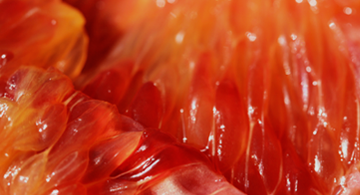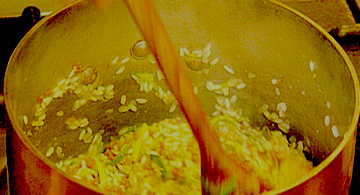
Radicchio, or leaf chicory, is a large, leafy perennial plant grown in many cool-weather areas of Italy and is related to lettuce (varieties include round, compact cappuccino and long romaine, spring cut lettuce and stem lettuce), cabbage, and escarole (varieties include scarola and riccia). Radicchio Rosso di Treviso is the Intybus species within the plant family Asteraceae and is an important commercial crop in northern Veneto grown without needing to follow strict government procedures for specific labeling. When the same plant is grown according to government I.G.P. procedures and passes inspection, it is labeled Radicchio Rosso di Treviso I.G.P. Indicazione Geografica Protetta, or Protected Geographical Indication, guarantees this radicchio is grown in the provinces of Treviso, Padova, and Venezia. While the I.G.P. document is several pages long, the main points are specific plants and dates of planting, growing methods, and harvest periods as necessary requirements for receiving this special government status.
Farmland: The sandy-clay soil of old flood plains must be suitable terrain, deep, well-drained and not too rich in nutrients, especially nitrogen.
Sowing of seed in the open field: Must be made June 1-July 31 of each year. Transplanting must be completed by August 31 of each year. After seeding, subsequent thinning of plants is required and should not exceed 8 plants per square meter.
Harvest: Depending when the plant is harvested determines its name, appearance, texture and taste. Harvest for Precoce (Early) begins September 1st. Harvest for Tardivo (Late) begins November 1 after the plant has lived through two frosts.
Varieties: Radicchio Rosso di Treviso I.G.P. – Precoce (Early) and Radicchio Rosso di Treviso I.G.P. – Tardivo (Late)
Radicchio Rosso di Treviso I.G.P. – Precoce (Early) means it is harvested early, beginning September 1 through October. The green leaves are brought together and bound gently to protect the plant’s interior or heart from direct sunlight. Similar to the method used for covering Belgian endive or white asparagus, this allows the heart to develop new leaves without light exposure, without chlorophyll development. From September through October new interior leaves develop into a compact heart in the center of the plant. When the radicchio plant is harvested during this time, layers of the outer dull green leaves are removed and discarded* until the stunning deep burgundy-purple heart is exposed, what we call “red radicchio”. (*Sometimes in the Treviso produce market, these limp, muddy discarded green leaves are sold for a few euros per kilo.)
The root is trimmed into a pointed stump and left on to keep the plant alive and fresh. Each Precoce heart is large, elongated, tightly closed. The broad leaves have a triangular white rib with white veining, are slightly bitter in taste and have a medium crunchy texture suitable for cooking or eating raw. It is especially good when served in salads, in soups, in sauces, braised, and baked. If radicchio plants are untied, some produce stalks with flowers and seeds while other plants grow red hearts but most plants spread out and grow green leaves. These plants are thought of as “the mother”. The heart grows when the plant’s base is placed in water. Once mature, some field plants are put into the cold storage room for a few months. Other field plants are cleaned and trimmed, tied into bunches like a bouquet of flowers, placed in very porous plastic containers and left in cool water for 20 to 25 days in a dark room. The water the plants are kept in is plain water, continuously and gently moving to aerate, no fertilizer is added. During these 20 to 25 days, new roots grow and the center grows a lovely red and white heart (what we think of as radicchio precoce).
Radicchio Rosso di Treviso I.G.P. – Tardivo (Late) means it is harvested late, from November 1 onwards, only after the plant has lived (and suffered) through two frosts. Each Tardivo heart is compact with thin, curled leaves, and the white ribs predominate over narrow red leaves, exactly the opposite of Precoce. Possessing a firmer, crunchy texture, Tardivo’s bitter flavor is mild and finishes with a sweet taste. It is better suited to serving raw with a Gorgonzola dip, dipping into batter and frying, or grilling.
Italian chicory, or radicchio, contains more antioxidants than other varieties of chicory and is a good source of dietary fiber and minerals. This leaf vegetable contains Vitamins B6, C, E and K, Pantothenic Acid, iron, magnesium, phosphorus, folate, potassium, copper, manganese, and zinc. One cup of radicchio, less than 2 ounces (57 grams), contains only 40 calories. In the Treviso area where radicchio is grown, radicchio is prepared for all courses of an Italian meal, from antipasti through dessert. Keeping the dish simple by using few ingredients allows the delicate sweetness and mild bitterness of radicchio to be enjoyed rather than overwhelmed.
Here are some traditional ways of preparing radicchio among the families living in Treviso:
*Quarter lengthwise and marinate overnight with extra-virgin olive oil and spices, then drain and serve.
*Risotto con Radicchio is a classic although now they usually add crumbled fresh pork sausage to the mix or shrimp, same for pasta.
*Contorni side dishes served at home, most Trevisani prepare it simply. Quarter lengthwise the head, lightly brushing with extra-virgin olive oil then grilling or baking in a medium hot oven for 15 to 20 minutes.
*Dip the long spears into a light batter, similar to tempura, fry and serve piping hot.
*Radicchio is slowly braised into marmellata to accompany boiled meats, boiled sausage and cheese as well as being preserved in oil or sott’olio.
*Often included in desserts, the best radicchio dessert is simple – dip fresh crunchy spears into warm melted bittersweet chocolate then enjoy.









